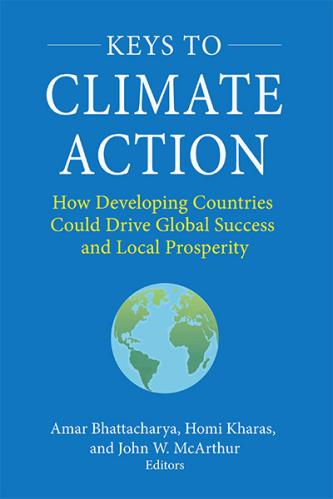Introduction
Economies stagnating. Governments overindebted. The ashes of war impeding progress on international cooperation. A widespread sense of malaise and absence of urgency blocking the mobilization of capital.
Such a narrative could easily describe much of the world in 2022. But it also describes Europe in 1947, a moment of societal doldrums that preceded an unexpected and dramatic shift in policy frames and public narratives, which ushered in a golden age of prosperity. The Marshall Plan played a crucial role back then, and its lessons can help inform a breakthrough Global Sustainability Program (GSP) today.
At the end of 1946, after a rapid post-World War II bounce, European economies started to stagnate at levels of output below those prevailing in 1938.1 Agricultural output fell by 3 percent in 1947, and industrial output in the third quarter of 1948 was no higher than at the end of 1946. People were hungry and cold; governments were overindebted and had exhausted much of their foreign exchange reserves; and countries were unable to trade with each other.
Like Europe after the war, sustainable development today seems stuck.
Against this backdrop, the Truman administration introduced a European Recovery Program, more commonly known as the Marshall Plan, to underpin U.S. national security by helping Europe recover.
Although there is disagreement as to the quantitative impact of the Marshall Plan, there is no doubt that it changed the European narrative. Eichengreen and Uzan (1992) describe the sentiment in 1947 as one of extreme pessimism caused by shortages of food, fuel, raw materials, and other supply bottlenecks, with governments unable to finance the repair of infrastructure, and businesses unable to access capital to buy raw materials or invest in new factories.
After Secretary Marshall’s speech at Harvard University in June 1947, when he promised to support any European plan “to the extent practical for us,” the European governments quickly convened a Committee on European Economic Cooperation with a plan to mobilize $29 billion over four years to achieve specific objectives of restoring industrial and agricultural output, establishing stable macroeconomic and financial conditions, and stimulating trade. The U.S. Congress passed a European Recovery Program and appropriated a first installment of $4 billion in 1948.
The rest is history: A Golden Age of economic growth and prosperity in Europe (and the United States) and many other parts of the world that lasted until at least 1970.
Today, we again need to change the narrative, this time through a Global Sustainability Program. Like Europe after the war, sustainable development today seems stuck. People are lost. But there is an opportunity to move forward if: (i) a strong political commitment to the Sustainable Development Goals (SDGs) and Paris Agendas encourages everyone to align investments to meet these goals; (ii) there is a credible technical plan outlining details of specific projects, policies, and institutional reforms; (iii) finance can be made to flow effectively at scale to sound sustainable investments; and (iv) institutions can properly implement the plans and strategies. Dealing with these components individually will not work. There is a chicken-and-egg problem, or a causality dilemma. Projects do not get developed if there is no finance. Finance is not forthcoming if there are no projects. This is not unusual. It is a problem that can be solved through a critical mass of actions. The same was true at the time of the Marshall Plan, and there are lessons from that period that are relevant today.
There is a need for a massive scaling-up of investments to achieve economic growth and meet the SDG and climate targets.
All developing country governments face a major challenge of how to decarbonize economies, preserve nature, and simultaneously generate economic prosperity and sustainable development. The sentiment is gloomy thanks to debt, food, energy and conflict crises, natural disasters, and species extinction and a rapidly degrading natural environment. Trust in international cooperation is low after broken promises on climate finance pledges and limited assistance for COVID-19 response, including for funding vaccination programs. Many middle-income countries have been excluded from programs of international assistance. They are hesitant to join others in a green transition without addressing their other pressing priorities for jobs, education, and health care. Their strategies integrate and balance “economic development” and “climate-related” investments but global processes for these two streams remain separate.
There is a need for a massive scaling-up of investments to achieve economic growth and meet the SDG and climate targets. These would cost an incremental $1.3 trillion a year in developing countries by 2025.2 The system of long-term development finance falls well short of being able to support projects at such a scale. U.S. Treasury Secretary Janet Yellen acknowledged as much in recent remarks at the IMF/World Bank Spring Meetings in April 2022:
“Experts put the funding needs in the trillions, and we’ve so far been working in billions. The irony of the situation is that while the world has been awash in savings—so much so that real interest rates have been falling for several decades—we have not been able to find the capital needed for investments in education, health care, and infrastructure.”3
In this policy brief, I argue that advanced economies (AEs) and China need to put in place a major program of economic support for all developing countries to assist them to transition to a new sustainable development path.
-
Footnotes
- Eichengreen and M. Uzan, 1992, “The Marshall Plan: Economic Effects and Implications for Eastern Europe and the Former USSR” Economic Policy, April, 1992, Vol. 7, No. 14, Eastern Europe, pp. 13-75.
- Bhattacharya et al., 2022, “Financing a big investment push.”
- Janet Yellen, April 13, 2022, Speech delivered at Atlantic Council.





